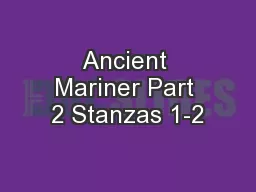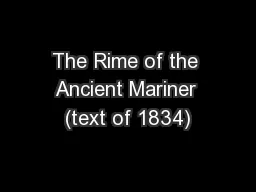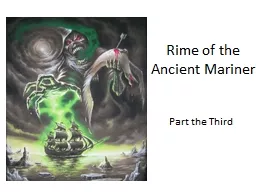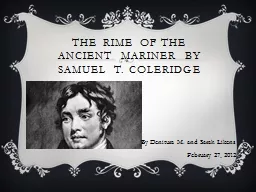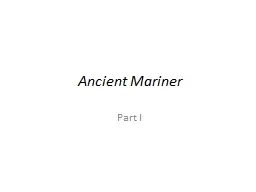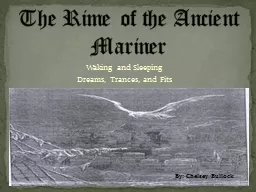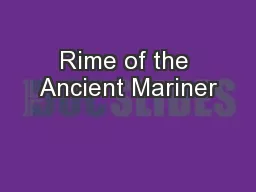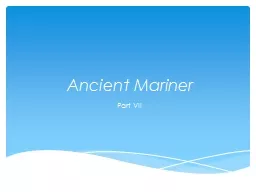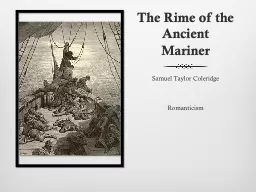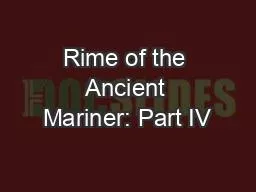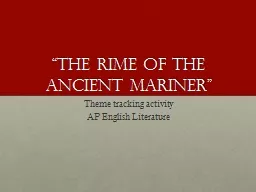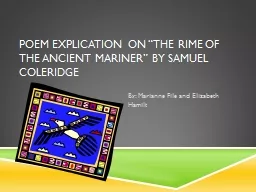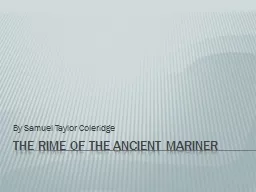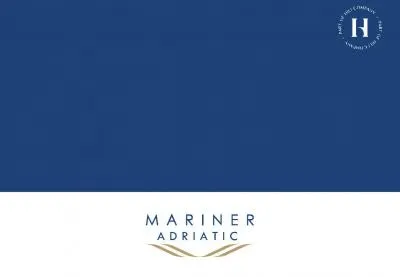PPT-Ancient Mariner Part 2 Stanzas 1-2
Author : debby-jeon | Published Date : 2018-09-24
The Sun now r ose upon the r ight 83 A Out of the sea came he B Still hid in mist and on the left C Went down into the sea B And the good south wind still
Presentation Embed Code
Download Presentation
Download Presentation The PPT/PDF document "Ancient Mariner Part 2 Stanzas 1-2" is the property of its rightful owner. Permission is granted to download and print the materials on this website for personal, non-commercial use only, and to display it on your personal computer provided you do not modify the materials and that you retain all copyright notices contained in the materials. By downloading content from our website, you accept the terms of this agreement.
Ancient Mariner Part 2 Stanzas 1-2: Transcript
The Sun now r ose upon the r ight 83 A Out of the sea came he B Still hid in mist and on the left C Went down into the sea B And the good south wind still . By: Samuel Taylor Coleridge. Rey Diaz and Sam Gilchrist. Poem. It is an ancient Mariner,. And he . stoppeth. one of three.. `By thy long grey beard and glittering eye,. Now wherefore . stopp'st. thou me?. By Samuel Taylor Coleridge. Argument. How a Ship having passed the Line was driven by storms to the cold Country towards the South Pole; and how from thence she made her course to the tropical Latitude of the Great Pacific Ocean; and of the strange things that befell; and in what manner the . Part the Third. There passed a weary time. Each throat(140). Was parched, and glazed each eye.. A weary time! a weary time!. How glazed each weary eye,. When looking westward, I beheld. A something in the sky.(145). By Denitura M. and Sarah Likens. February 27, 2012. Literal Sense of the Poem. The . story of a mariner who is on a long voyage and runs into three men who are en route to a wedding. He proceeds to tell him a story about the albatross that he killed and that he must continue to tell the story throughout eternity.. Part I. Latin Epigraph. Latin Epigraph of Ancient Mariner. Ep"i. *graph. (?), n. . 1.. Any inscription set upon a building; especially, one which has to do with the building itself, its founding or dedication.. Dreams, Trances, and Fits. The Rime of the Ancient Mariner. By: . Chelsey. Bullock. There are many moments in each story or text that at some point will describe waking and sleeping by starting a new day. When the sun goes down you are to sleep and when the sun comes up you are to awake. That is the cycle of living.. Audience, Purpose, and Tone. Theme…. How do you know when someone is acting guilty? Give specific examples from your own experiences. What does guilt do to you? . ISOLATION. DIVISION . “Rime of the Ancient Mariner” . Why is the Hermit on the Pilot’s boat?. Why a Hermit & not a priest?. Can he absolve (shrieve) the Mariner’s sin & alleviate his burden?. Carry over questions….. First Stanza (514-518). Samuel Taylor Coleridge . Romanticism. Background. Originally published in 1798 as The Rime of the . Ancyent. . Marinere. .. the language . went against the emerging Romantic tradition of writing in contemporary, unrhymed language . Andrew Perricone • Imogen Rosenbluth. Kalev Rudolph • Alyssa Stump. Stanzas 1 & 2. 'I fear. thee, ancient Mariner!. I fear . thy . skinny hand. !. And thou art . l. ong,. . l. ank, and brown,. Theme tracking activity . AP English Literature . INstructions. Each group will be assigned a particular theme to “track” throughout the poem. Evidence should be located throughout the poem; do not merely focus on one part. . By: Marianne File and Elizabeth . Hamilt. Literal sense in a Poem. 1) a. At first, the sailors were quite upset with the Mariner and the fact that he killed the Albatross. When the fog cleared though, the sailors decided that the bird didn’t control the breezes but the fog so then they congratulated him. Then the breezes slowed down and the ship became idle. Some of the sailors dreamed that a spirit followed beneath the ship from the land of mist and snow. The sailors . By Samuel Taylor Coleridge . Overview:. The Rime of the Ancient Mariner is a ballad, meaning that it is a poem that tells a story and has a sing-song quality. . There are seven parts to the poem.. The poem is a frame story, just like Frankenstein. . 1. Data. People. 100. Area. Quay length. 60,000 sqm. 330 metres. Depth. 8.0 metres. Storage capacity. 1,550. . ground slots. Reefer plugs. 312. Equipment. 3x Mobile . harbour. cranes. 4x Reach stackers.
Download Document
Here is the link to download the presentation.
"Ancient Mariner Part 2 Stanzas 1-2"The content belongs to its owner. You may download and print it for personal use, without modification, and keep all copyright notices. By downloading, you agree to these terms.
Related Documents

